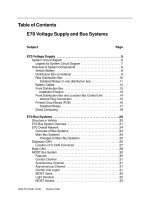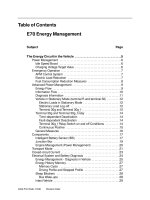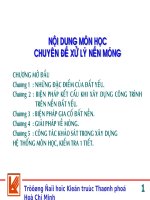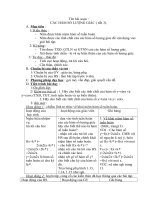C712 03
Bạn đang xem bản rút gọn của tài liệu. Xem và tải ngay bản đầy đủ của tài liệu tại đây (21.33 KB, 2 trang )
Designation: C 712 – 03
Standard Test Method for
Bubbling of One-Part, Elastomeric, Solvent-Release Type
Sealants1
This standard is issued under the fixed designation C 712; the number immediately following the designation indicates the year of
original adoption or, in the case of revision, the year of last revision. A number in parentheses indicates the year of last reapproval. A
superscript epsilon (e) indicates an editorial change since the last revision or reapproval.
5. Apparatus
5.1 Plates, thin aluminum, approximately 3 in. (76 mm)
wide by 5 in. (127 mm) long by 0.012 in. (0.30 mm) thick.
5.2 Blocks, cement mortar, approximately 2 in. (51 mm)
wide by 4 in. (102 mm) long by 1 in. (25 mm) thick prepared
as described in Test Methods D 1191.
1. Scope
1.1 This test method covers determination of the degree of
bubble formation or surface blistering in one-part, elastomeric
solvent-release type sealants when exposed to elevated temperatures.
1.2 The subcommittee with jurisdiction is not aware of any
similar ISO standard.
1.3 This standard does not purport to address all of the
safety concerns, if any, associated with its use. It is the
responsibility of the user of this standard to establish appropriate safety and health practices and determine the applicability of regulatory limitations prior to use.
NOTE 1—Other substrates such as brick, cast stone, marble, stainless
steel, etc., may be specified either in place of the standard materials
specified in 5.1 and 5.2 or in addition to them.
5.3 Frame, flat, rectangular, of 1⁄8-in. (3.2-mm) steel or
brass, with an opening of 1 by 33⁄4 in. (25 by 95 mm) and
outside dimensions of approximately 2 by 43⁄4 in. (51 by 121
mm).
5.4 Spatula, steel, with knife edge.
5.5 Oven, forced-draft type, having a temperature controlled
at 122 6 3.6°F (50 6 2°C).
2. Referenced Documents
2.1 ASTM Standards:
C 717 Terminology of Building Seals and Sealants2
D 1191 Test Methods for Concrete Joint Sealers3
6. Test Specimen
6.1 Take the test specimen from a previously unopened
container as received from the sealant manufacturer.
3. Terminology
3.1 Definitions—Refer to Terminology C 717 for definitions
of the following terms used in this test method: compound,
elastomer, elastomeric, sealant, solvent-release sealant, substrate.
7. Procedure
7.1 Prepare three test specimens on each substrate as follows: Center the frame on the test substrate and carefully fill it
with compound, avoiding air pockets. Strike off the surface of
the compound flush with the frame, to a uniform thickness of
1⁄8 in. (3.2 mm). With the spatula, cut all around the outside
edge of the compound and lift the frame straight up and off.
7.2 Condition the specimens for 48 h at 73.4 6 3.6°F (23 6
2°C) and 50 6 5 % relative humidity.
7.3 Place the specimens in the oven at 122 6 3.6°F (50 6
2°C) for 72 h.
7.4 After heat exposure, allow the specimens to cool at 73.4
6 3.6°F (23 6 2°C) for 1 h.
7.5 Examine each specimen for surface gas bubbles and
blisters.
4. Significance and Use
4.1 The type and amount of solvent used in these sealants
can sometimes give rise to surface bubbling and blistering
problems. The substrate used, whether porous or nonporous,
will also have an effect. Although blistering is often caused by
misapplication, this test method is useful in differentiating
between a sealant that develops an acceptably smooth surface
and one that may have blistering tendencies.
1
This test method is under the jurisdiction of ASTM Committee C24 on Building
Seals and Sealants and is the direct responsibility of Subcommittee C24.20 on
General Sealant Standards.
Current edition approved May 10, 2003. Published June 2003. Originally
approved in 1972. Last previous edition approved in 1997 as C 712 – 93 (1997).
2
Annual Book of ASTM Standards, Vol 04.07.
3
Discontinued. Replaced by D 5329. See 1995 Annual Book of ASTM Standards,
Vol 04.03.
Copyright © ASTM International, 100 Barr Harbor Drive, PO Box C700, West Conshohocken, PA 19428-2959, United States.
1
C 712 – 03
TABLE 1 Precision and Bias Data
8. Report
8.1 For each substrate, report the total surface area covered
by the bubbles or blisters, estimated to the nearest 0.1 in.2 (65
mm2). The area of bubble formation may be estimated by
superimposing on the specimen a glass or clear plate ruled into
1⁄2-in. (13-mm) squares.
Material Average
G1
G2
G3
9. Precision and Bias 4
9.1 The precision and bias calculations for this test method
are based on the results of four laboratories testing three
materials using five specimens per test. The results are given in
Table 1.
0.000
0.064
0.011
Estimated Standard Deviation
Within
Laboratory
Estimated Standard Deviation
Between Laboratories
Repeatability
Interval
Reproducibility
0.000
0.209
0.028
0.000
0.212
0.020
0.000
0.590
0.079
0.000
0.600
0.078
9.1.1 At 95 % confidence level a variation of as much as
0.59 in.2 can be expected within a laboratory and 0.60 in.2
between laboratories. This is based on three materials being
tested by four laboratories.
10. Keywords
10.1 bubbling; elastomeric; solvent-release sealant
4
Supporting data have been filed at ASTM International Headquarters and may
be obtained by requesting Research Report RR: C24–1021.
ASTM International takes no position respecting the validity of any patent rights asserted in connection with any item mentioned
in this standard. Users of this standard are expressly advised that determination of the validity of any such patent rights, and the risk
of infringement of such rights, are entirely their own responsibility.
This standard is subject to revision at any time by the responsible technical committee and must be reviewed every five years and
if not revised, either reapproved or withdrawn. Your comments are invited either for revision of this standard or for additional standards
and should be addressed to ASTM International Headquarters. Your comments will receive careful consideration at a meeting of the
responsible technical committee, which you may attend. If you feel that your comments have not received a fair hearing you should
make your views known to the ASTM Committee on Standards, at the address shown below.
This standard is copyrighted by ASTM International, 100 Barr Harbor Drive, PO Box C700, West Conshohocken, PA 19428-2959,
United States. Individual reprints (single or multiple copies) of this standard may be obtained by contacting ASTM at the above
address or at 610-832-9585 (phone), 610-832-9555 (fax), or (e-mail); or through the ASTM website
(www.astm.org).
2





![MAKE magazine [OH] 03](https://media.store123doc.com/images/document/13/ce/fj/medium_fjg1388298702.jpg)



